We love our trees, but we also love our coffee and electronic devices and are bereft without our electricity. It is reported that more than 90% of tree-related service interruptions are caused by healthy tree branches that have broken as a result of storms, ice or high winds. As I’m writing this in late January, I’m happy to report that thus far, Lancaster County hasn’t experienced anything like the terrible storm of February 2017; however, we’ve had numerous power interruptions caused by storm-related fallen trees and branches.
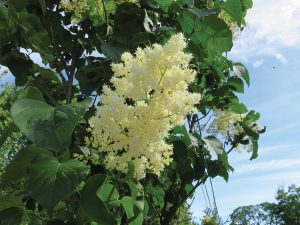 During last fall’s mild weather, I noticed tree-trimming crews doing preventative work all over the streets and roads of our area. Power companies typically employ professional arborists for this type of work; however, the sort of directional trimming they must do focuses on the location of the tree branches in relation to the power line and usually considers a growth cycle of four years. Trees trimmed for power line clearance are often significantly changed in appearance. The trimming practices restrict the width, height and potential impact of trees near lines. In some cases, complete tree removal is necessary.
During last fall’s mild weather, I noticed tree-trimming crews doing preventative work all over the streets and roads of our area. Power companies typically employ professional arborists for this type of work; however, the sort of directional trimming they must do focuses on the location of the tree branches in relation to the power line and usually considers a growth cycle of four years. Trees trimmed for power line clearance are often significantly changed in appearance. The trimming practices restrict the width, height and potential impact of trees near lines. In some cases, complete tree removal is necessary.
Drive down any street and you will spot trees hacked (well, trimmed) into unnatural looking V-shapes around power lines. The fact is any tree branches over 25 feet high are in the trimming zone. A neighbor went to work in the morning with a beautiful full tree canopy at the front of his property and came home in the evening to find it trimmed into an unnatural form.
Homeowners can reduce this need to trim trees by selecting a suitable tree to plant near power lines. Only trees that mature to a height of 25 feet or less should be planted under or within 10 feet of utility posts. Trees that grow 20-40 feet tall should be no less than 25-35 feet away, and those taller than 40 feet at a 45-60 feet distance.
Although they would wish no trees near their service lines, the websites of power companies often have long lists of trees they recommend for planting under power lines. I have some specific recommendations for species that will not not be a threat to overhead wires (or become overgrown in smaller yards).
Before purchasing any of my recommendations, discuss your soil and sun exposure conditions with an expert at a fine nursery to be sure your choice will thrive. Also, put thought into where you position your tree around your home since it will impact the amount of energy you use for heating and cooling.
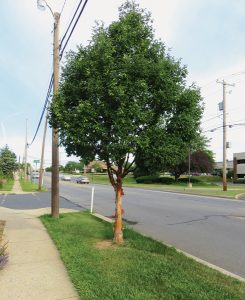 Good Choices for Street Trees
Good Choices for Street Trees
Paperbark Maple Acer griseum: Grows 20-25 feet high, it’s trouble-free, slow-growing and particularly noted for its exfoliating copper-orange to cinnamon-brown bark and showy red fall color. Highly recommended!
Japanese Tree Lilac Syringa verticulata: Grows 20-25 feet high, with an upright oval form. It displays very showy upright (12-inch) panicles of creamy-white (not fragrant) flowers in June. Very adaptable to most soils and relatively tolerant of drought, salt and urban settings. Look for the cultivar ‘Ivory Silk’ (beautiful shiny reddish-brown bark).
Loebner magnolias Magnolia x loebneri: Grows 20-25 feet high. Magnolia hybrids are prized for their smooth light-gray bark and abundant fragrant pink and white 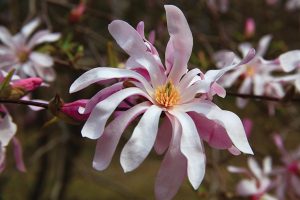 flowers in April. The flowers of many magnolias can be toasted by a late frost, but I can recommend the cultivar ‘Lennard Messel’, which flowers late. Magnolias are not tolerant of poor drainage or road salt.
flowers in April. The flowers of many magnolias can be toasted by a late frost, but I can recommend the cultivar ‘Lennard Messel’, which flowers late. Magnolias are not tolerant of poor drainage or road salt.
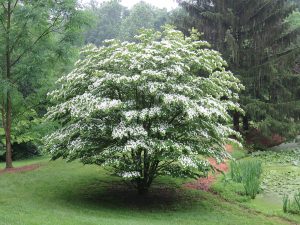 Kousa Dogwood Cornus kousa: Grows 15-20 feet high. White flowers appear in June with the foliage (several weeks after the native dogwoods). By August the tree is covered with large raspberry-like fruit that’s relished by birds. Fall color is reddish-purple. With age, the exfoliating bark is very attractive. Kousa is not subject to anthracnose, the ubiquitous foliar disease of the native dogwood (Cornus florida). It is a stunning four-season tree.
Kousa Dogwood Cornus kousa: Grows 15-20 feet high. White flowers appear in June with the foliage (several weeks after the native dogwoods). By August the tree is covered with large raspberry-like fruit that’s relished by birds. Fall color is reddish-purple. With age, the exfoliating bark is very attractive. Kousa is not subject to anthracnose, the ubiquitous foliar disease of the native dogwood (Cornus florida). It is a stunning four-season tree.
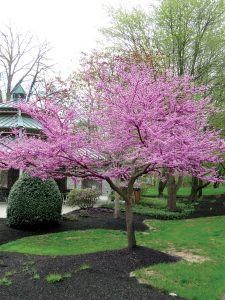 Eastern Redbud Cercis canadensis: Grows 20 feet high. This native is fast growing with a flat-topped shape. Depending on cultivar, it displays white or vibrant pink flowers in early spring, and its heart-shaped foliage turns bright yellow in the fall. ‘Forest Pansy’ has purple foliage. Sensitive to road salt.
Eastern Redbud Cercis canadensis: Grows 20 feet high. This native is fast growing with a flat-topped shape. Depending on cultivar, it displays white or vibrant pink flowers in early spring, and its heart-shaped foliage turns bright yellow in the fall. ‘Forest Pansy’ has purple foliage. Sensitive to road salt.
Smoketree Cotinus coggygria: Grows 10-15 feet high, its small flowers in the spring change to large purplish-pink, fluffy, hazy, smoke-like panicles throughout summer. The fall color can be red-purple to orange-red. There are several purple- or gold-foliaged cultivars. Similar in habit and bloom but with far superior fall color (the best fall color of any of our natives), the American smoketree, Cotinus obovatus, is difficult to find even in large nurseries.
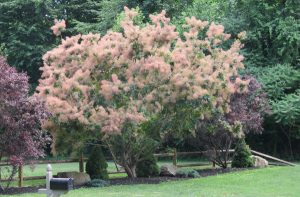 Dwarf crab apples and ornamental cherries are often recommended and exhibit the right growth habit, but I do not recommend them because they are single-season trees (spring flowers) and are subject to foliar diseases that render them unsightly much of the growing season. And, I most emphatically do not recommend Bradford pears.
Dwarf crab apples and ornamental cherries are often recommended and exhibit the right growth habit, but I do not recommend them because they are single-season trees (spring flowers) and are subject to foliar diseases that render them unsightly much of the growing season. And, I most emphatically do not recommend Bradford pears.
Don’t let your newly-planted trees dry out during the first two years. When rain is inadequate and during our hot August days, generous weekly watering is essential. How to properly plant a tree was discussed in an earlier Gardening Journey.
If your service lines are underground, before getting out the shovel, be sure to call 811 to have the locations of underground service identified – not just power lines, but LP lines, invisible pet fences, septic lines and outdoor lighting wires.
Additional good choices are:
- Blackhaw Viburnum Viburnum prunifolium
- Arrowwood Viburnum Viburnum dentatum
- Seven Son Tree Heptacodium miconioides
- Witch Hazel Hamamelis virginiana
- Cornelian Dogwood Cornus mas
- Stewartia Stewartia pseudocamellia
- Crepe Myrtle Lagerstroemia indica
- Winter King Hawthorn Crataegus viridis ‘Winter King’
- Korean Mountain Ash Sorbus alnifolia

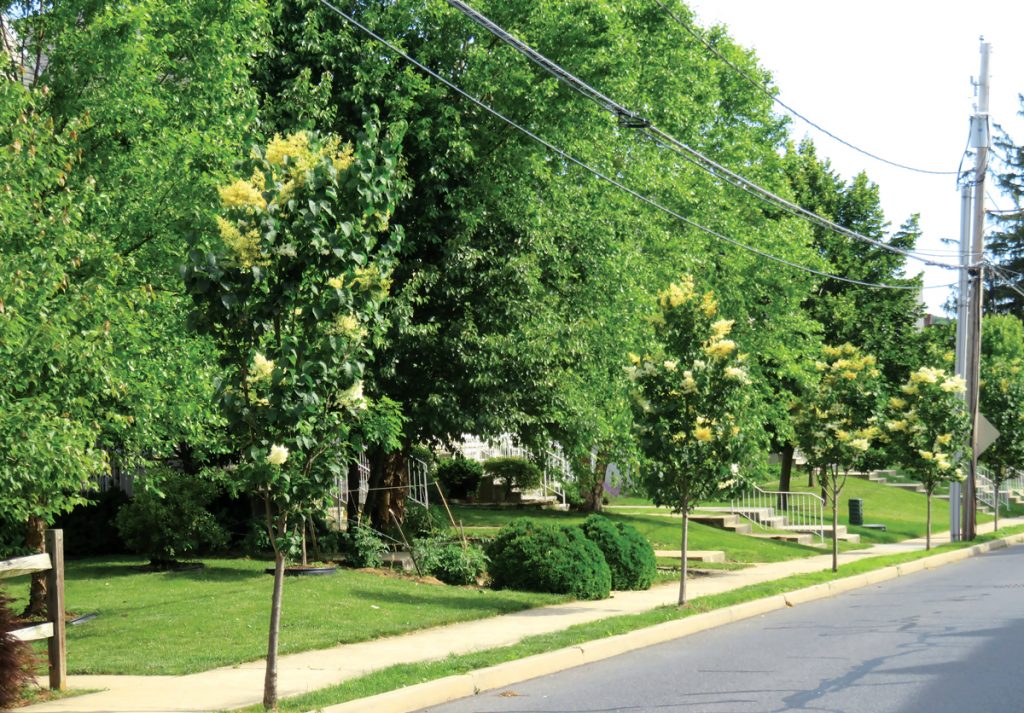
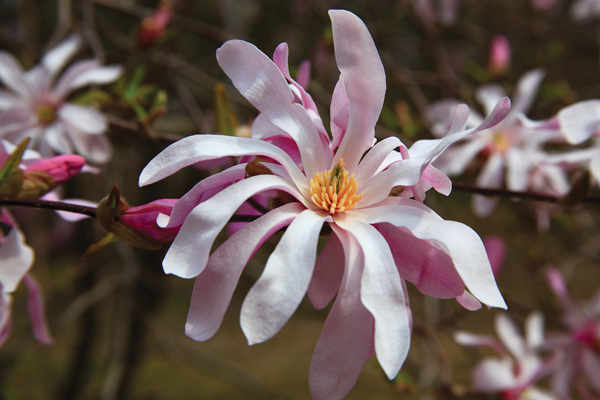
It’s good to know that tree branches over 25 feet high are in the trimming zone. I have a Maple Acer in my front yard and it’s starting to get close to the power line by the sidewalk. I’ll have to call a tree trimming service to cut back the branches so it doesn’t reach that power line.